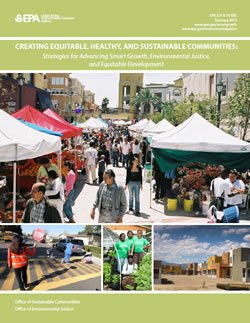Creating Equitable, Healthy, and Sustainable Communities

Communities across the country are integrating smart growth, environmental justice, and equitable development approaches to design and build healthy, sustainable, and inclusive neighborhoods.
Creating Equitable, Healthy, and Sustainable Communities: Strategies for Advancing Smart Growth, Environmental Justice, and Equitable Development (pdf) (2013) offers low-income, minority, tribal, and overburdened communities approaches that can guide development to respond to their needs and reflect their values.
It provides a menu of land use and community design strategies that bring together smart growth, environmental justice, and equitable development principles and that community-based organizations, local and regional decision-makers, developers, and others can use to revitalize their communities.
Strategies are grouped under seven common elements:
- Facilitate Meaningful Community Engagement in Planning and Land Use Decisions.
- Promote Public Health and a Clean and Safe Environment.
- Strengthen Existing Communities.
- Provide Housing Choices.
- Provide Transportation Options.
- Improve Access to Opportunities and Daily Necessities.
- Preserve and Build on the Features That Make a Community Distinctive.
This resource also provides examples of development that diverse communities can apply to promote a clean and safe environment, a strong economy, and good quality of life for all residents. For example:
- Residents of Spartanburg, South Carolina partnered with the local government, federal agencies, and industry stakeholders to create new housing, parks, businesses, and health clinics where brownfields, landfills, and abandoned buildings once existed.
- On the Ohkay Owingeh reservation in New Mexico, tribal leaders implemented a Master Land Use Plan to create affordable housing, preserve valuable water resources, and revive traditional Pueblo settlement patterns and historic plazas.
- Bethel New Life, a faith-based community development corporation on Chicago’s West Side, formed a regional coalition to preserve transit service in the predominantly African-American neighborhood and led the construction of shops, child care facilities, an employment center, and energy-efficient and affordable homes around a train station.
Creating Equitable, Healthy, and Sustainable Communities was developed jointly by EPA’s Office of Environmental Justice and Office of Community Revitalization. It was also informed by comments from 40 reviewers received through a public comment process.
Find more resources on smart growth and equitable development.
